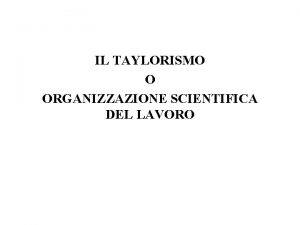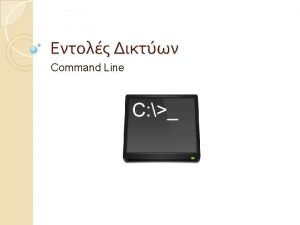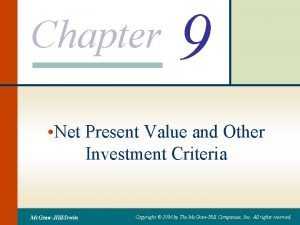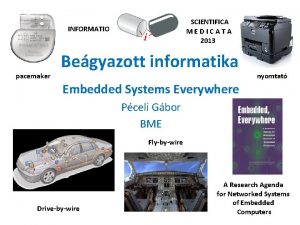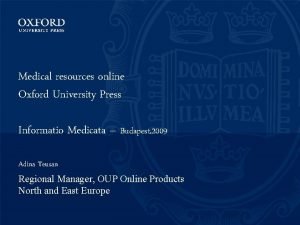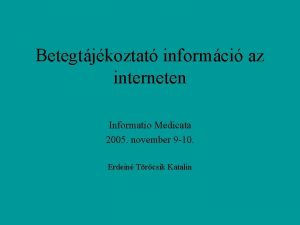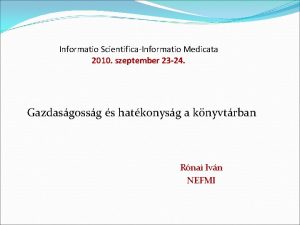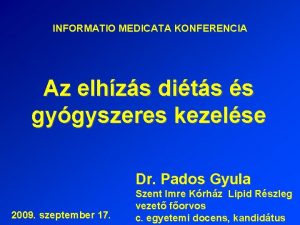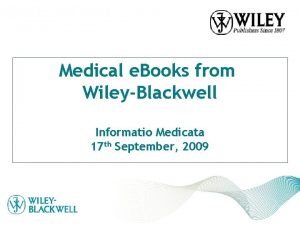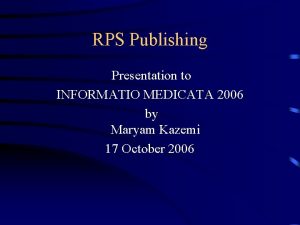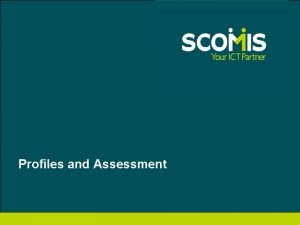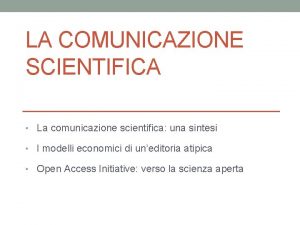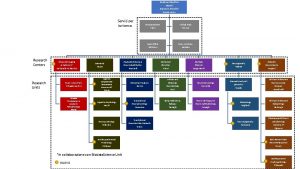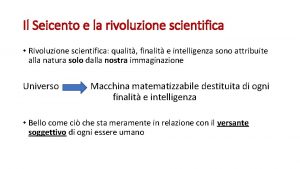INCITESTM INSTITUTIONAL PROFILES Informatio Scientifica Informatio Medicata David

















- Slides: 17

INCITESTM INSTITUTIONAL PROFILES Informatio Scientifica / Informatio Medicata David Horky September 2011 Country Manager – Central & Eastern Europe david. horky@thomsonreuters. com

In. Cites – Institutional Profiles Introduction & Overview • The global Institutional Profiles project is an initiative to collect factual data about academic institutions in all regions for the purposes of creating informative profiles of their activities. • The objective is to profile more than 1, 000 of the leading academic institutions around the world. • The first use of this data has been to inform Times Higher Education’s World University Rankings. • Thomson Reuters will now also make this information available as a component of In. Cites, to complement Global Comparisons and Research Performance Profiles.

In. Cites – Institutional Profiles Three main sources of data Academic reputation survey Institution submitted data Bibliometric data Profiles Project

In. Cites – Institutional Profiles Academic Reputation Survey • An annual survey of active academics and researchers around the world. Participants are polled to give feedback on the reputation of institutions in their subject area. • A clear distinction between the reputation for Research and that for Teaching • Invitation only. • Multiple languages Respondents are predominantly academics (2010) – Academic staff 69% – Research staff 15% – Institutional leadership 7% – Graduate/post graduate students 6% http: //science. thomsonreuters. com/globalprofilesproject/gpp-reputational/

In. Cites – Institutional Profiles Institutional Data Gathering • Thomson Reuters collects factual data directly from the participating institutions • Thomson Reuters has made considerable efforts to collect high quality, internationally comparable data while minimizing the work burden. – Use existing authoritative data sources when available – Common data definitions for all institutions / countries – Strong support structure – Data validation using third party data

In. Cites – Institutional Profiles Bibliometric data • Utilizes the Thomson Reuters Web of Science data, considered the gold standard by many evaluation bodies globally. • Many bibliometric indicators can be generated. Combinations of bibliometric and institutional data can create new and unique indicators. – Papers per (academic + research staff) – Citation impact – Papers per research $ – Research power • Data must be normalized.

In. Cites – Institutional Profiles Data Analysis and Interpretation • Analysis and interpretation of the data is essential. • Modifications of data for comparability. • Benchmarking / normalization: – Data for one institution is compared to the average for the all institutions to understand the performance. – There are fundamental differences in different disciplines and normalization of the data is essential for fair comparisons. – Understand where an institution fits within the distribution of all institutions.

In. Cites – Institutional Profiles The 2010 -2011 Thomson Reuters Methodology 13 indicators, across five broad areas of a university’s activity, covering the three core missions of every university: Ø Teaching Ø Research Ø Knowledge Transfer

In. Cites – Institutional Profiles Ø Approximately 500 institutions from 47 countries. Ø A Profile exists for each participating institution Launching in June 2011

In. Cites – Institutional Profiles: View an Institutional Profile Viewing an Institutional Profile is a good intro to general information components as well as radar graphs. The menu is extremely simple, easy to use.

In. Cites – Institutional Profiles: View an Institutional Profile

In. Cites – Institutional Profiles: View an Institutional Profile The Research Footprint is a Radar Graph that illustrates the relative strength or weakness of performance indicators. It is accompanied by a table containing three measures of size, strength or activity for each indicator

Selections: In. Cites – Institutional Profiles: Comparing Institutions 1) 2) 3) 4) Mc. Gill Univ, Mc. Master Univ, etc. “Reputation – Research” Life Sciences 2008 Compare Institutions through Creation of Research Footprints Select up to five institutions. Groups -- Each Indicator Group consists of between 5 and 9 indicators. For each group, one radar graph will be generated for each institution or country average you selected in step 1.

Selections: In. Cites – Institutional Profiles: Comparing Institutions 1) 2) 3) 4) Mc. Gill Univ, Mc. Master Univ, etc. “Reputation – Research” Life Sciences 2008 The Footprints provide an instant visual impression of comparative performance for this particular Indicator.

In. Cites – Institutional Profiles: Comparing Institutions Compare Institutions through Creation of Trend Graphs Select up to six institutions. A trend graph illustrates the activity or progress of one indicator in one subject area. 1. Select at least one institution. You may select up to six. Each line on the graph will plot the activity, growth or progress of one institution. 2. Select an indicator and a subject area. Each point on the graph will represent a value of the selected indicator for each year. You may select more, but a graph is generated for each pairing of an Indicator and Subject Area. 3. Select a time period. Each point on the x-axis will be a year in the time period you specify.

In. Cites – Institutional Profiles: Comparing Institutions

INCITESTM INSTITUTIONAL PROFILES: an introduction Informatio Scientifica / Informatio Medicata David Horky September 2011 Country Manager – Central & Eastern Europe david. horky@thomsonreuters. com
 Informatio
Informatio Informatio security
Informatio security Notazione scientifica
Notazione scientifica Ruffo fisica
Ruffo fisica Divisione con notazione scientifica
Divisione con notazione scientifica Organizzazione scientifica del lavoro
Organizzazione scientifica del lavoro Legge scientifica di copertura
Legge scientifica di copertura Ipconfig netsh
Ipconfig netsh Excessive concavity welding
Excessive concavity welding Corporate traveller profile
Corporate traveller profile Profitability index ba ii plus
Profitability index ba ii plus Walker royce software project management
Walker royce software project management Payback ch 10
Payback ch 10 Specific flashing profiles
Specific flashing profiles Chemical composition of silica sand
Chemical composition of silica sand Tectonic hazard profile
Tectonic hazard profile Who are the ewells in to kill a mockingbird
Who are the ewells in to kill a mockingbird Npv profiles
Npv profiles





